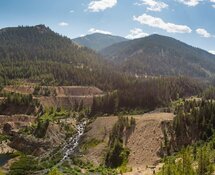The Gold Report: Eric, you primarily cover mining companies in Québec, one of Canada's most mining-friendly provinces. However, last month the Parti Québécois (PQ) won a minority mandate. Are the glory days for Québec's mining sector over?
Eric Lemieux: Without saying the glory days are over, the election of the Parti Québécois will definitely put things on hold. The PQ has a very pro-environment and anti-mining perspective based on the personal convictions of certain ministers.
I think the PQ will change some of the priorities in Québec. I do not know if it will turn out to be effectively anti-mining. I think its people will just want to do things differently or give the perception that they are doing things differently. Recall the PQ held a very pro-ecological, anti-mining electoral stance that went in-line with the "printemps érable" (Maple Spring Arising) with the student protests.
At the end of the day, I am optimistic that Québec will continue as a favorable jurisdiction, just maybe not as favorable as it used to be.
TGR: Do you think Plan Nord—the initiative to build a road to several mining projects in the northern part of the province—will be canceled?
EL: I do not. The PQ has said it believes in some elements of Plan Nord.
Plan Nord has wealth-generating elements; it is indeed the plan of a generation, so a long-term view is essential. Some parts of the plan have started to move forward on the infrastructure side. It would be counter-productive to stop road construction after having cut down so many cubic meters of trees. The PQ will have to analyze situations like that and come up with a balanced approach, perhaps case by case.
In many ways, the PQ's stance does not hold up. It wants to fully develop Québec and it favors entrepreneurship. But it also wants to increase taxes and change the rules of the game. That damages a stable business environment. I believe certain proposed infrastructures of the Plan Nord should go ahead either for practical reasons (investments mobilized) or because they may fit with the PQ "Maître chez-soi" doctrine. I think there will be a fine-tuning of the Plan Nord.
TGR: Will the sovereign investment funds in Québec have a say in what happens with Plan Nord?
EL: I believe so and would expect that their expertise and experience would hold some sway. Eventually, the sovereign funds should have a word with the PQ and explain that if the PQ wants them to invest in Québec companies, the PQ must give companies the occasion and encouragement to move forward in a stable framework and conducive business environment.
TGR: Junior mining companies operating in Québec get roughly half of their exploration tax back through tax breaks. Will those disappear?
EL: Probably not, largely because of the potential backlash from the regions that really profit from those tax breaks. I am talking about regions such as the Abitibi, which, incidentally, voted for the PQ. I think companies there, such as service providers, would stand up and argue that rolling back tax breaks would be going too far toward killing the golden goose.
As much of an advantage as the tax break is for the companies, it also has a larger ripple economic effect—the employment created and sustained by exploration activities. For example, Val-d'Or has been very vibrant in the last two years because of just that second-stage effect. If the PQ starts to play around with that, the people in the regions will say, no, we need this help to sustain the activities. This is all the more reason that there is a certain cooling of activities in light of current economic uncertainty and cycles in commodities prices.
TGR: Can you give us some recent examples of exploration success in Québec due, at least in part, to those tax breaks?
EL: Well most junior discoveries in the past decade can be traced to exploration activities funded by flow-through financings. The Detour Gold Trend is presently on my radar screen. I cover three companies in that area: Balmoral Resources Ltd. (BAR:TSX.V; BAMLF:OTCQX) and its Martiniere play, Midland Exploration Inc. (MD:TSX.V) and Adventure Gold Inc. (AGE:TSX.V).
All three are within 20 kilometers (km) of Detour Gold Corp. (DGC:TSX). When Detour gets into production in early 2013, it could well become Canada's biggest gold mine.
TGR: Detour Gold is on the other side of the border in Ontario.
EL: Yes, but the geology does not subscribe to political borders. The same geological trend extends into Québec. The Detour Gold Trend is a structure that crosses into both Québec and Ontario, similar to the famous Cadillac-Larder Lake Fault. We know there is a World Class deposit being built on the Ontario side with Detour. On the Québec side, the Fenelon deposit was worked on in the 1990s. Fenelon was very rich, but very small. The sizeable overburden depth and limited access has precluded much advance exploration. However, works by Balmoral, Midland and Adventure may result in new discoveries and advancements.
TGR: In August Balmoral announced the discovery of three new mineralized zones outside of the known extent of the Martiniere gold system. Its share price went up on that news. What happens now?
EL: I cannot be very specific at this moment, but the company believes it is justified in drilling more to determine the size of this emerging gold system.
TGR: Somewhat unlike Balmoral, Midland uses the prospect generator model, but it does not have a standout project. Will Midland have a flagship project in the near future?
EL: Midland does not necessarily need a flagship project to succeed at this stage. To the contrary, I think it is a bit like playing the piano. You can play different notes, not just tap on the same key.
The broad picture for Midland is the value of diversification in its projects, commodities and partners. The stock has held up and it has several potential flagship projects, any one of which could really light up or become a takeout by one of its partners. An example is Osisko Mining Corp.'s (OSK:TSX) Casault project on the Detour Trend. It is still very early stage but Midland attracted the interest of a major gold company on an early play by selling the story based on technical merits. That is a testament to the quality of Midland's technical team. My target price on Midland is $2.75/share.
TGR: What about Midland's Eleonore and James Bay projects? They are near Goldcorp Inc.'s (G:TSX; GG:NYSE) Eleonore deposit, now in development.
EL: Neither one has been drilled, but they are very well located.
Midland has been working on its Eleonore project, mostly prospecting work, for three summers. It is preparing to farm Eleonore out to a partner or to reach the point where Midland will have sufficient data to do its own drilling campaign.
As to James Bay East, this is an underexplored area. Midland and Virginia Mines Inc. (VGQ:TSX) are the only key players in that area.
Virginia Mines is my top pick right now. As Goldcorp derisks Eleonore the value of Virginia's royalty there will be rerated. Virginia also has a strong pipeline of projects in northern Québec. This company knows how to explore and it is good at it.
One of Virginia's latest news was trenching results in early September 2012 on its Wabamisk project, which is about 60km southwest of Eleonore. This is an area Virginia worked in the past and it is now amassing a huge land position there. The company plans to drill intensively at Wabamisk this winter; there appears to be a big alteration system. This is an example of the wisdom of going back to an area, using new models and coming up with interesting stuff. I think Virginia's portfolio of royalties and projects justifies my $17/share target price.
TGR: Might Midland team with Virginia?
EL: I would not expect that. But, if an exchange of ideas will make it a bigger land package, more of an area play, that could attract a bigger company and then there might be a merger of projects.
Going back to Plan Nord, this is an area that should benefit from its road-building component. The Route 167 extension will go from Mistissini to Stornoway Diamond Corp.'s (SWY:TSX) Renard project. There is talk of continuing from Stornoway up north to the Trans-Taiga Road and the hydropower plants of Hydro-Quebec's La Grande complex. If that happens, the road will go through the eastern James Bay area, where Midland and Virginia are active. That would add value to those projects.
TGR: You put out a note on Adventure Gold in mid-September. What did that have to say?
EL: Adventure Gold announced an increase in the size of its Pascalis-Colombière property, which is about 30km east of the town of Val-d'Or. It is in a sweet spot, in that there is no residential area nearby, but it is close enough for workers to live at home and drive to the mine site. There is a premium to that, which we sometimes overlook.
Pascalis-Colombière is in a mining and industrial area. Train tracks and the Beaufor mine owned by Richmont Mines Inc. (RIC:TSX; RIC:NYSE.MKT) are just a couple of kilometers to the south and northwest.
Adventure Gold continued drilling that project this summer using a geological model that appears to confirm the presence of a gold system that had been overlooked when Cambior Inc. [now part of IAMGOLD Corp. (IMG;TSX; IAG:NYSE)] mined a small gold deposit there. The Pascalis-Colombière project should have an initial resource estimate by the end of October. I believe that this should set the stage for a rerating of the stock.
TGR: Are there any connections between Adventure Gold's management team and Richmont's?
EL: Jules Riopel, Adventure Gold's vice president of exploration, previously worked for Richmont. I think they have a cordial business relationship, along the lines of being neighbors and being curious about what the other is doing. I do not know if there is an official exchange of information. Obviously it would be natural for Richmont to look seriously at Pascalis-Colombière.
TGR: What is your target price on Adventure Gold?
EL: I have a $1.20/share target price.
TGR: You seem to favor companies near existing mines or developing projects. What are other aspects of your investment thesis?
EL: One key element is the quality of the management. You need to know who management is, what their track records are, what the industry sentiment is about them.
I also appreciate focus—on specific projects and geological models—that will lead the pack that goes beyond looking right next door to another company's recent discovery.
That being said, I do favor companies near existing mines or developing projects. I think you can often seize occasions when you understand what is happening in a certain area. That is how I make the relationship between existing mines and developing projects. I also highlight that the partnership model has its merit; in tough times this is a great way to remain active and keep some measure of cash and survive for another day.
Finally, I appreciate the under-promising and over-delivering mantra.
TGR: You recently visited mineral exploration projects in the Yukon. That was a hot region a few years ago, and then it cooled off. What is happening there now?
EL: I was there in mid-September, but had the chance to visit only Comstock Metals Ltd.'s (CSL:TSX.V) QV project.
There has been a slow down, which is somewhat typical. The first discovery happens, followed by excitement, which then quiets down; it is the natural process I believe.
But, putting it in context, the Yukon is remote. It is not that easy to work. The Yukon Territory would probably benefit from a pro-mining policy to build infrastructure similar to what Québec has done by building roads and hydroelectric plants. If the Yukon Territory could build a power plant in conjunction with mining projects, it would have end-users to buy the power. That makes practical, political and governmental sense.
TGR: But Hydro-Québec had a strong tax base to draw on and pay for its development in Northern Québec. The Yukon has one-twentieth of the population.
EL: True, but I am not talking about the same scale. For example, if you dam a river for a hydroelectric plant in the Yukon, mining companies would be your first customers, but the supplemental power generated could be fed to communities farther away. That would be a forward-thinking policy that is win-win for all parties.
But getting back to your initial question, I think things are re-brewing in the Yukon. Kaminak Gold Corp. (KAM:TSX.V), who rode some of the initial play in the White Gold District, and ATAC Resources Ltd. (ATC:TSX.V) in eastern Yukon are now coming out with some interesting results again.
If people have confidence in what they are doing, it can be good to take a step back, slow down and sometimes revisit a project later on. A case in point is the exploration team of Virginia Mines. Virginia Mines' strength is that it does not work all the deposits in its portfolio at once. It is willing to put a project on hold, maybe for three or four years, then revisit it from a different angle.
TGR: Comstock has an option to earn 100% ownership of the QV Project in the Yukon's White Gold District. What does that option mean?
EL: Basically, an option is a way for a company to acquire something for a certain amount of money. It is a way to spread the risk between the optioneer and the optionee. Comstock optioned QV from Shawn Ryan and Cathy Wood. Options are quite common in the mining industry.
An option is usually a win-win situation. The optionees, in this case Shawn Ryan and Cathy Wood, receive monetary consideration upfront and through staged payments. Optionees also usually get a net smelter return (NSR) royalty.
TGR: And Comstock, if it spends a certain amount of money on exploration over a given period of time period, will receive its 100% interest.
EL: Exactly. My understanding is that Comstock will gain 100% interest through staged payments, issuing shares and completing the exploration work over a four-year period. The deal involves $230,000 in cash, 1.25 million (M) shares and $1.25M in exploration commitments. Additionally, a 2% underlying NSR royalty (1% may be purchased for $2.5M) is attached. This particular agreement follows the norm.
TGR: Recent trenching on QV suggested values of up to 3.74 grams per ton gold over 75 meters (m) in a part of Canada that has not seen any glaciation. Is that important?
EL: It is quite interesting, because it is so far north one would think everything had once been covered with ice.
Having no glaciation means that the material underground has not been transported great distances by surface erosion and the movement of glaciers. So, when you dig a trench, the soil sample you take at a certain depth is likely to be representative of the rock below.
This really helps in the geological and geochemical evaluation, especially in some parts of the Yukon, where there are so few outcrops.
TGR: Comstock is drilling QV now. What will it take to move the stock price?
EL: Simply put: assay results. Comstock just finished its 2012 program: eight diamond holes drilling on almost 1,235m. This was a first phase following the summer trenching works. My understanding is that the drilling is indicating the presence of a gold system. It will be interesting to follow the assay results.
TGR: When you visited QV, could you see any visible gold in the core?
EL: Yes, I saw visible gold. I photographed it. But I do not necessarily equate visible gold to a significant gold interception. I prefer to see a system. I prefer to see alteration, something that suggests that fluids passed through. Also, experience says to await the assay results.
It was reassuring to talk with the knowledgeable people who are running the show there at the QV project. Some of them worked on the Underworld Resources Inc.'s [now part of Kinross Gold Corp. (K:TSX; KGC:NYSE)] Saddle discovery in the White Gold District. They know what type of rock is interesting.
TGR: Are there any other stories you'd like to share with our readers?
EL: Eagle Hill Exploration Corp.'s (EAG:TSX.V) Windfall Lake project has been producing some interesting drill results. This project is 100km east of the Lebel-sur-Quevillon. Its second resource estimate is about now 1.3 million ounces. Geologically, this looks very interesting.
NioGold Mining Corp. (NOX:TSX.V; NOXGF:OTCPK) is not rated but it is with Aurizon Mines Ltd. (ARZ:TSX; AZK:NYSE.MKT). They have the Marban project just northeast of Osisko's Canadian Malartic mine. It has good results and the companies have published resource estimates. Also, Cartier Resources Inc. (ECR:TSX.V) came out with some interesting results on its Pusticamica gold project.
I have Premier Gold Mines Ltd. (PG:TSX) as a buy with a target price of $7.50/share. It has a growing portfolio of properties in Ontario and Nevada, both well-known, gold-endowed districts in stable jurisdictions.
TGR: Is Premier a takeover target?
EL: Premier owns 49% of its portfolio of projects in the Red Lake District. Goldcorp is the operator. So, Goldcorp would perhaps be a natural suitor.
All I know is that Premier has positioned itself as a great explorer and now as developer. Ebe Scherkus, the chairman, is bringing Premier to another level.
TGR: Eric, thank you for your time.
Eric Lemieux is a mining analyst who joined Laurentian Bank Securities in 2008. He worked for nine years as a consultant responsible for applying Regulation NI 43-101. He has worked at the Montreal Exchange, and prior to that managed exploration projects for Cambior, Noranda and Soquem. He holds two master's degrees, in mineral economics from the Colorado School of Mines and in metamorphic-structural geology from Laval University.
Want to read more exclusive Gold Report interviews like this? Sign up for our free e-newsletter, and you'll learn when new articles have been published. To see a list of recent interviews with industry analysts and commentators, visit our Exclusive Interviews page.
DISCLOSURE:
1) Brian Sylvester of The Gold Report conducted this interview. He personally and/or his family own shares of the following companies mentioned in this interview: None.
2) The following companies mentioned in the interview are sponsors of The Gold Report: Balmoral Resources Ltd., Midland Exploration Inc., Adventure Gold Inc., Detour Gold Corp., Goldcorp Inc., Comstock Metals Ltd., Aurizon Mines Ltd. and Premier Gold Mines Ltd. Streetwise Reports does not accept stock in exchange for services. Interviews are edited for clarity.
3) Eric Lemieux: I personally and/or my family own shares of the following companies mentioned in this interview: Adventure Gold Inc., Aurizon Mines Ltd., Comstock Metals Ltd., Cartier Resources Inc., Eagle Hill Exploration Corp., Goldcorp Inc., Kaminak Gold Corp., Kinross Gold Corp., Midland Exploration Inc., NioGold Mining Corp., Stornoway Diamond Corp. and Virginia Mines Inc. I personally and/or my family am paid by the following companies mentioned in this interview: None. I was not paid by Streetwise Reports for participating in this interview.










































